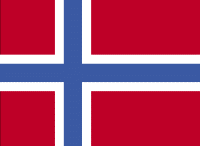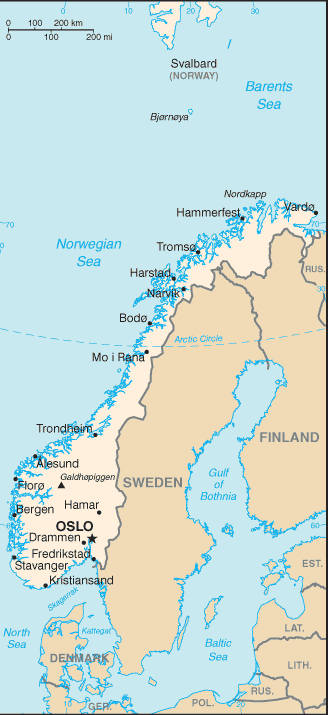Topics Covered
Welcome to Norway
Overview of Resources
Metals
Industrial Minerals
Fossil Fuels
Investment
Sources
Welcome to Norway
Norway is located in northern Europe and borders the North Atlantic Ocean and the North Sea. The country has a total area of 323,802 km2 and a total population of 4,707,270 as per 2012 estimates. The country’s climate is temperate along the coast and colder in the interior parts.
 |
The national flag of Norway.
Image Credit: CIA Factbook |
The country is richly endowed with natural resources such as nickel, pyrites, titanium, lead, copper, zinc, iron ore, natural gas and petroleum. According to 2011 reports, the country generated nearly $500 billion through the petroleum sector.
Although the country opted out of the European Union (EU), it contributes to the EU budget by remaining as a member of European Economic Area. After experiencing a steady GDP growth during 2004 to 2007, its economy slowed down in 2008 and 2009 due to the global economic crisis. The country's GDP was $269.3 billion in 2011.
Overview of Resources
Norway has vast reserves of petroleum, titanium, nickel, natural gas, iron ore and coal. Globally, it ranked fifth in the production of natural gas and second in export of natural gas. The country’s titanium production accounts for 6% of the total world production of titanium. It is a globally leading producer of ferroalloys and aluminium.
The country also produces zinc, steel, copper, cobalt, cadmium and aluminium. Some of the country’s economically important industrial minerals include sand and gravel, nepheline syenite, limestone and aggregates.

The map of Norway. Image Credit: CIA Factbook
Metals
In 2010, Norsk Hydro ASA planned to construct an aluminium recycling plant at Karmoy, which would have an initial production capacity of 35,000 metric tons per year (Mt/yr). The plant is likely to be operational this year at a cost of about $39.5 million.
Iron ore is mined from Mine at Mo i Rana by Rana Gruber A/S. The annual production capacity of iron ore from the mine is 2,000 Mt.
In 2010, Fundia AB acquired the steel plants at Christiania, Mandal Stal, Mo i Rana, and Spigerverk, which have a combined steel production capacity of 600 Mt.
Industrial Minerals
In 2010, 100 Mt of Feldspar was mined from Lillesand mine by SCR Sibelco Nordic A/S. However, in the same year, the company announced the closure of the mine owing to the decreasing market demand and high processing cost of feldspar.
Fossil Fuels
Store Norske Spitsbergen Kulkompani A/S is the country’s sole producer of coal. Coal mining is mainly undertaken in the Svalbard Arctic Archipelago,one of the most remote places in the Artic. Svalbard has two mines, namely, Svea Nord and Gruve 7 Mine. Nearly 25,000 t of coal produced from Gruve 7 Mine is used in the country’s coal-fired power station, and rest of the coal is exported. In 2011, Store Norske planned to invest $17 million in Gruve 7 Mine to develop the infrastructure of the mine.
Troll-Oseberg field is the country’s largest natural gas field. With the establishment of new fields in the Norwegian Sea and the Barents Sea, the country’s natural gas reserves were estimated to be 2 trillion m3 as of January 2010.
The estimated reserves of petroleum in the country were 5.67 billion barrels as per January 2010 reports. All the reserves located offshore on the Norwegian Continental Shelf are divided into three regions, namely, the Norwegian Sea, the North Sea and the Barents Sea. Large amounts of petroleum were extracted from the North Sea in 2010.
Investment
Norway’s diverse geologic regions offer a broad spectrum of mineral resources for development and exploration. However, an important matter of concern in the country is the dumping of tons of waste rock from the mining activities into the deep Norwegian fjords. Scientists from the Norwegian Institute for Water Research are conducting studies to analyze the consequences of this activity in detail.
The exploration and drilling activities in the Barents Sea and the Norwegian Sea is likely to continue. Drake Resource has recently acquired the Joma mine, which produced 11.5 million t of 1.45% zinc and 1.49% copper before production was stopped in 1998, and the Gjersvik mine, which produces 500,000 t of 0.6% zinc and 2.15% copper.
Upon signing the Exploration and Exploitation Agreement for acquiring two mines, Drake will pay NOK75,000 (A$11,819) to Joma Naeringspark, which is the commercial branch of the Røyrvik Commune. It has also planned to invest NOK250,000 for exploration activity in these mines.
Furthermore, the Norwegian Petroleum Directorate has plans to establish new offshore areas in the arctic region. The significant growth of the country’s natural gas and petroleum sector in the past 10 years has contributed a lot to Norway’s economy and this situation is likely to continue in the future.
Disclaimer: The Author of this article does not imply any investment recommendation and some content is speculative in nature. The Author is not affiliated in any way with any companies mentioned and all statistical information is publically available.
Sources
Disclaimer: The views expressed here are those of the author expressed in their private capacity and do not necessarily represent the views of AZoM.com Limited T/A AZoNetwork the owner and operator of this website. This disclaimer forms part of the Terms and conditions of use of this website.